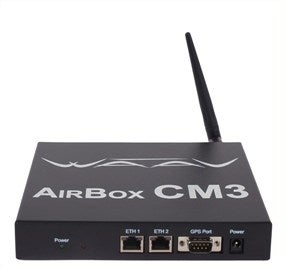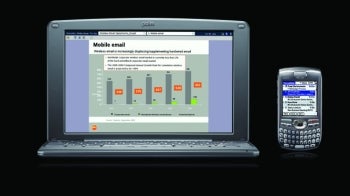Let’s face it: The line between personal and business life for most small-business owners isn’t blurred — it’s obliterated. But this can be as much of a blessing as it is a curse, if you have the technology to make it work in your favor. You can spend a sunny Thursday in a park rather than in a gloomy hotel room and colleagues will be none the wiser. And since clients will inevitably need you after hours and on the weekends, you can be as responsive from home as you would be from the office without needing to trek back to headquarters. Here are eight tips and tools that let you stay connected wherever business takes you.
 |
| The Sprint PX-500 card (by Pantech Wireless) lets you tap into the carrier’s 3G mobile broadband network. |
1. Connect Your Office and Mobile Phones.
“Today’s 24/7 work environment requires everyone – especially small business owners and employees – to be accessible even during the summer when everyone is trying to spend time away from the office,” said Tom Shaughnessy, director of business marketing for Sprint. “Advances in wireless technology can really help small business owners stay connected, and they allow you to coordinate with clients and employees while simultaneously growing the business.”
Shaughnessy’s first bit of advice: Use a forwarding service that routes office-bound calls to your cell phone automatically when you are out of the office. Most business-telephone providers offer this capability, and it lets you give out your precious mobile phone number to a select few but still receive important calls.
2. Forget Wi-Fi Hot Spots
Shaughnessy also recommends that frequent travelers look into a mobile broadband data service, such as those offered by AT&T, Verizon and, of course, Sprint. “Staying connected to the Internet doesn’t mean you have to remain anchored to your desktop computer,” he said. “And on the road, Wi-Fi hot spots can be unreliable.”
A laptop equipped with a 3G data card (typically $100 or less) or built-in mobile broadband circuitry (a $150 option from most major notebook makers) will let you tap into the carrier’s high-speed wireless network at near-DSL speeds. Most metro markets in the U.S. are now covered by wireless broadband, and you can easily recoup the $60 to $80 monthly service fee in the money you’ll save not paying Internet connection fees at hotels and hot-spots.
 |
| WAAV’s AirBox lets you turn share your mobile broadband service on a wired or wireless network. |
3. Create a Mobile Hot Spot
A company called WAAV takes mobile broadband service to the next level with its AirBox line of mobile broadband routers. These boxes tap into a carrier’s 3G network (typically EV-DO) on the back end, and allow you to create a local wired or wireless network wherever you happen to be—even in a moving vehicle.
4. Not Your Kid’s Walkie-Talkies
If you have a mobile workforce concentrated in a given area, a phone service with push-to-talk (or “walkie-talkie”) capabilities might be a better fit than a pure cell-phone service. Think IM versus e-mail: Members of your team can chat back and forth at the push of a button, rather than dialing each other for quick conversations.
5. Make Your Cell Phone Work Better
There are few things more annoying or unprofessional than having to cut a client’s call short because you need to move to a spot with better cell-phone reception. zBoost Cell Zone signal boosters from Wi-Ex can help. These handy devices (from $99 and up) grab even a weak cell-phone signal and amplify it in a given coverage area (say, inside your home or office), making your cell phone more useful—and less of a nuisance.
 |
| Palm’s Foleo turns your smartphone into a full-fledged communications appliance. |
6. E-mail On the Go.
Corporate netizens, of course, have anywhere access to e-mail from their smart phones and PDAs, thanks to a robust servers and ‘round-the-clock IT personnel to keep the system humming. But small business owners, too, can have e-mail delivered reliably to their mobile devices without having to spend a fortune. For example, Everyone.net, a leading e-mail hosting service provider, has introduced its Mobile E-mail service, providing simple, secure and synchronized e-mail-on-the-go for most smart phones. Best of all, it’s free of charge for subscribers of the company’s Business Mail service.
7. Collaboration Knows No Bounds
Working together is easy when everyone is clustered in a single office. But if you want you and your employees to be unshackled from your desks, you need a collaboration solution. There are several good choices aimed at small businesses, such as HyperOffice, BlueTie and Collanos. One of the latest (it’s still in beta, in fact) is Foldera, a next-generation information organizer and collaboration service. This Web-based solution offers file-sharing, automatic e-mail sorting, online project collaboration and much more in an intuitive user interface.
8. Improve PDA Perfomance
Composing long e-mails of documents on you PDA can be an exercise in, well, thumb exercise. Palm, the company that made the PDA a business staple, has introduced the Foleo. This $499 smartphone companion lets you see e-mails and documents on its roomy 10-inch screen (beat that, iPhone) and create them on a full-size keyboard, making your mobile lifeline a whole lot easier to live with.
Jamie Bsales is an award-winning technology writer and editor with nearly 14 years of experience covering the latest hardware, software and Internet products and services.
| Do you have a comment or question about this article or other small business topics in general? Speak out in the SmallBusinessComputing.com Forums. Join the discussion today! |

